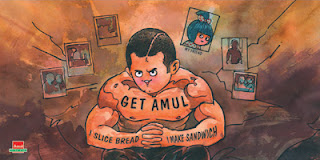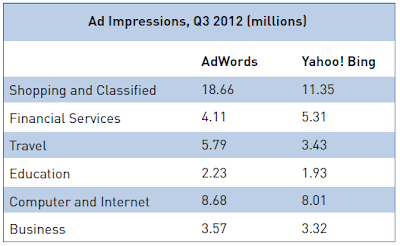Marketing Communications over the last decade has taken a big leap (of faith!) with the advent of interactive, super-fast, inter-connected world wide web and the myriad web technologies. All the critical pillars of communications - message, media, consumers, design tools, skill-sets etc have undergone a change.
Or I should say, the technological advances have brutally demanded a change in the way we think, create and execute brand communications.
The creative process required to roll out a print ad or a TV campaign is very different than the process of creativity required to create a message on the Internet. Building a website, designing a search campaign or executing a social media campaign requires a completely different kind of skill set.
Media, in the good old days was the kingdom of the media planners and the buyers, today the scene is fragmented. Adwords professionals are equally important media buyers and planners. With content aggregation and inbound marketing, the media is not even always a paid commodity. There goes the 15% commission revenue model.
With Internet and technology, the content is no longer uni-directional, aimed at the consumers. User generated content has become a major source of content. Youtube and the whole of social media runs on user generated content. They are interestingly multi-directional. Even TV, Print and Radio have not stayed uni-directional with the advent of tools like Shazam and QR code
Consumers of media have also changed in terms of time spent on each media, attention span and general lifestyle attitude towards brands. Television and Print have lost a good deal of youth in the age group of 15-24 to these new media. Even a cricket match is getting tracked through tweets and Facebook updates.
For the advertisers, it has not been easy. The tools, the terminologies, the knowledge domain is now not with one big agency. There are so many things to know to implement an effective advertising campaign. We need to not only know vector images, illustrator, TRP, Readership and the works, but also know Impressions, PPC deals, HTML5, JAVA, Email, SMS technologies and the whole new media related knowledge.
The client servicing teams and the other creative, studio and production departments of the bigger advertising agencies have not been able to cope up with the digital onslaught. With media and creative separating in around 2003, it only added to their woes.
A marketing company now has to deal with a creative agency, a media agency, a digital agency, a website agency and a technology company for mini interactive applications. At one end, it may be taken as a positive outcome that the industry is moving towards specialized businesses and services, improving the quality of services, helpful to the economy in general.
At the other end, it is diluting the concept of advertising. There is no single brand custodian. The advertising agency used to be brand custodian in the good old days, but the advertising industry has lost its credibility or ability to be the brand custodian. Today, there seems to be no unanimous decision on who is the brand custodian today. The level of confusion in the definition of 'brand custodian' is quite funny (and stupid).
In a 2008 HT article, Madhukar Sabnavis, Country Head – Planning and Discovery, Ogilvy & Mather India, once said, “The marketing director or the marketing head is the brand’s custodian.” MG Parameswaran, Executive Director, Draft-FCB-Ulka, once said, “The CEO of the company that owns the brand, is the brand’s custodian.” Lynn D’Souza, head, Lintas Media Group, says, “The brand manager is the brand’s custodian.”
The brand custodian is the person or team that knows the brand the best. Brand, from a marketing communications perspective, is what the consumers perceive or feel or believe; or what the consumers should perceive or feel or believe. The advertising agencies used to have an Account Planner or an Account Planning team that used to understand this aspect of branding. They used to understand the consumer behavior behind brands.
Understanding consumer behavior, or the interest to seek this understanding makes the basis for effective communication. The effort required to understand consumer behavior in this world of fragmented myriad media scenario is a big challenge. But it is a possible challenge.
The second basic truth about advertising is that it is exponentially effective if there is convergence of media. 360 degree communication in true spirit is the need of the hour (and always been the need)
For an advertiser and a marketing person, it is always easier to have one brand expert managing the whole gamut of communication. There is a need for a consultative cum outsourcing business model to provide an effective 360 degree communications services to advertisers.
We at TSO - The Significant Other, work in the this new media paradigm. We are working hard to make ourselves experts in consumer behaviour in terms of media consumption, branding and purchase cycle behavior so that we can create the most relevant message. We also tried hard to understand all the available media so that we can sent the most relevant message through the most appropriate media, through the model of outsourcing.
Outsourcing is the key to the execution of such a strategy. In effect, appropriate knowledge and experience in liasonning with all the myriad vendors is the key.
Or I should say, the technological advances have brutally demanded a change in the way we think, create and execute brand communications.
The creative process required to roll out a print ad or a TV campaign is very different than the process of creativity required to create a message on the Internet. Building a website, designing a search campaign or executing a social media campaign requires a completely different kind of skill set.
Media, in the good old days was the kingdom of the media planners and the buyers, today the scene is fragmented. Adwords professionals are equally important media buyers and planners. With content aggregation and inbound marketing, the media is not even always a paid commodity. There goes the 15% commission revenue model.
With Internet and technology, the content is no longer uni-directional, aimed at the consumers. User generated content has become a major source of content. Youtube and the whole of social media runs on user generated content. They are interestingly multi-directional. Even TV, Print and Radio have not stayed uni-directional with the advent of tools like Shazam and QR code
Consumers of media have also changed in terms of time spent on each media, attention span and general lifestyle attitude towards brands. Television and Print have lost a good deal of youth in the age group of 15-24 to these new media. Even a cricket match is getting tracked through tweets and Facebook updates.
For the advertisers, it has not been easy. The tools, the terminologies, the knowledge domain is now not with one big agency. There are so many things to know to implement an effective advertising campaign. We need to not only know vector images, illustrator, TRP, Readership and the works, but also know Impressions, PPC deals, HTML5, JAVA, Email, SMS technologies and the whole new media related knowledge.
The client servicing teams and the other creative, studio and production departments of the bigger advertising agencies have not been able to cope up with the digital onslaught. With media and creative separating in around 2003, it only added to their woes.
A marketing company now has to deal with a creative agency, a media agency, a digital agency, a website agency and a technology company for mini interactive applications. At one end, it may be taken as a positive outcome that the industry is moving towards specialized businesses and services, improving the quality of services, helpful to the economy in general.
At the other end, it is diluting the concept of advertising. There is no single brand custodian. The advertising agency used to be brand custodian in the good old days, but the advertising industry has lost its credibility or ability to be the brand custodian. Today, there seems to be no unanimous decision on who is the brand custodian today. The level of confusion in the definition of 'brand custodian' is quite funny (and stupid).
In a 2008 HT article, Madhukar Sabnavis, Country Head – Planning and Discovery, Ogilvy & Mather India, once said, “The marketing director or the marketing head is the brand’s custodian.” MG Parameswaran, Executive Director, Draft-FCB-Ulka, once said, “The CEO of the company that owns the brand, is the brand’s custodian.” Lynn D’Souza, head, Lintas Media Group, says, “The brand manager is the brand’s custodian.”
The brand custodian is the person or team that knows the brand the best. Brand, from a marketing communications perspective, is what the consumers perceive or feel or believe; or what the consumers should perceive or feel or believe. The advertising agencies used to have an Account Planner or an Account Planning team that used to understand this aspect of branding. They used to understand the consumer behavior behind brands.
Understanding consumer behavior, or the interest to seek this understanding makes the basis for effective communication. The effort required to understand consumer behavior in this world of fragmented myriad media scenario is a big challenge. But it is a possible challenge.
The second basic truth about advertising is that it is exponentially effective if there is convergence of media. 360 degree communication in true spirit is the need of the hour (and always been the need)
For an advertiser and a marketing person, it is always easier to have one brand expert managing the whole gamut of communication. There is a need for a consultative cum outsourcing business model to provide an effective 360 degree communications services to advertisers.
We at TSO - The Significant Other, work in the this new media paradigm. We are working hard to make ourselves experts in consumer behaviour in terms of media consumption, branding and purchase cycle behavior so that we can create the most relevant message. We also tried hard to understand all the available media so that we can sent the most relevant message through the most appropriate media, through the model of outsourcing.
Outsourcing is the key to the execution of such a strategy. In effect, appropriate knowledge and experience in liasonning with all the myriad vendors is the key.





